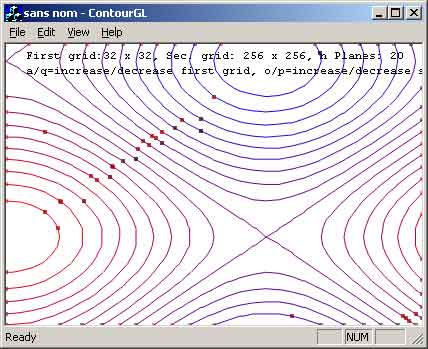In this article, you will learn about a contour plot class, which is an improved version of the Level Curve Tracing Algorithm. It was designed to draw iso-contour of a user-defined function f(x,y).

Introduction
This article presents a contour plot class. It is designed to draw iso-contour of a user-defined function f(x,y). I wrote it to integrate it in a graphic library: Plot Graphic Library
The class is based on the algorithm presented in [1] (Check References section). It is basically an improved version of the Level Curve Tracing Algorithm.
Understanding the Algorithm
The algorithm uses several tuning parameters that the user must choose in order to have the best quality/performance ratio of the algorithm:
- Domain of x,y:
double pLimits[4]={0,1,2,3,4};
CContour contour;
contour.SetLimits(pLimits);
- Size of the primary grid: The grid on which evaluate the function
f(x,y). See SetFirGrid, GetColFir, GetRowFir. The parameter influences greatly the quality of the contour. - Size of the secondary grid: The grid where the function is going to be evaluated. This grid can be much finer that the first grid. See
SetSecGrid, GetColSec, GetRowSec.
Classes
CContour
Main contour class. This class cannot be directly but has to be inherited. The inherited class must implement the ExportLine function. To generate contours, use
void Generate()
Make to have set the field function (f(x,y)) before calling this function. The function will call ExportLine for each new segment.
CGLContour
Use this class to draw contours to an OpenGL device context.
CListContour
Use this class to generate contour and store them as line strip. The user can retrieve each contour and use it as he wills. This function uses two sub-classes:
CLineStrip, a list < int > containing the index of the pointsCLineStripList, a list <CLineStrip*>
The line strip can be accessed by:
CLineStripList* GetList(iPane);
where iPane is the index of the contour.
How To...
Set Up a Contour Object
Suppose that we have inherited a class from CContour and overridden ExportLine function.
class CMyContour : CContour
{
void ExportLine(...);
}
Now, first set the function f(x,y):
double myF(double x, double y)
{ [...] return ... };
CMyContour contour;
contour.SetFieldFcn(myF);
Then set the iso-contour values, i.e.:
int n;
CMyContour contour;
vector<double> vIso(n);
for (int i=0;i<n;i++)
{ ... }
contour.SetPlanes(vIso);
The contour is ready to be used.
Draw Contours using OpenGL
Use CGLContour as inherited function of CContour.
CGLContour contour;
[...]
contour.Generate();
Retrieve Contours in Line Strip
Use CListContour as inherited function of CContour. Only the index of the points with respect to second grid are stored in the list. You can access their real value by using GetXi() and GetYi() functions.
CGLContour contour;
[...]
contour.Generate();
CLineStripList* pStripList;
pStripList=contour.GetLines(0);
ASSERT(pStripList);
CLineStrip::iterator pos;
for (pos=pStripList->begin();
pos != pStripList->end() ; pos++)
{
pStrip=(*pos);
ASSERT(pStrip);
if (pStrip->empty())
continue;
[...]
}
Updates
- 31st August, 2002: Added contribution from Chenggang Zhou: better strip compression, threshold merging, area of strip, boundary detection, also some minor changes I don't remember...
- 4th March, 2002: All the code is now using STL. :)
References
License
This article has no explicit license attached to it, but may contain usage terms in the article text or the download files themselves. If in doubt, please contact the author via the discussion board below.
A list of licenses authors might use can be found here.
